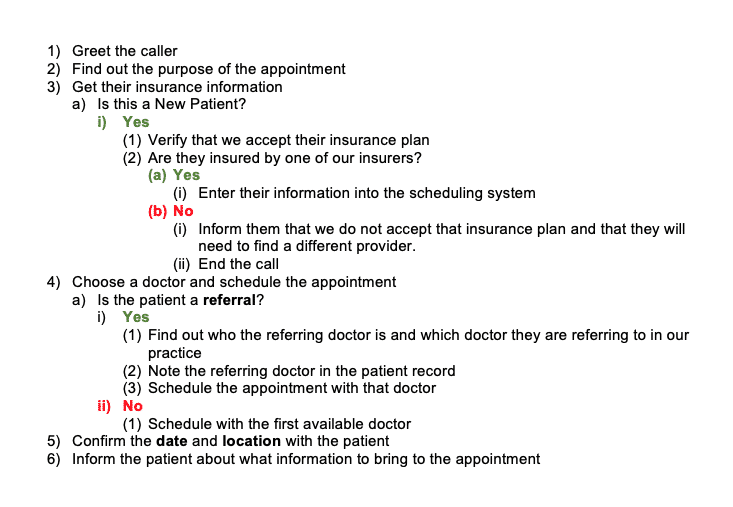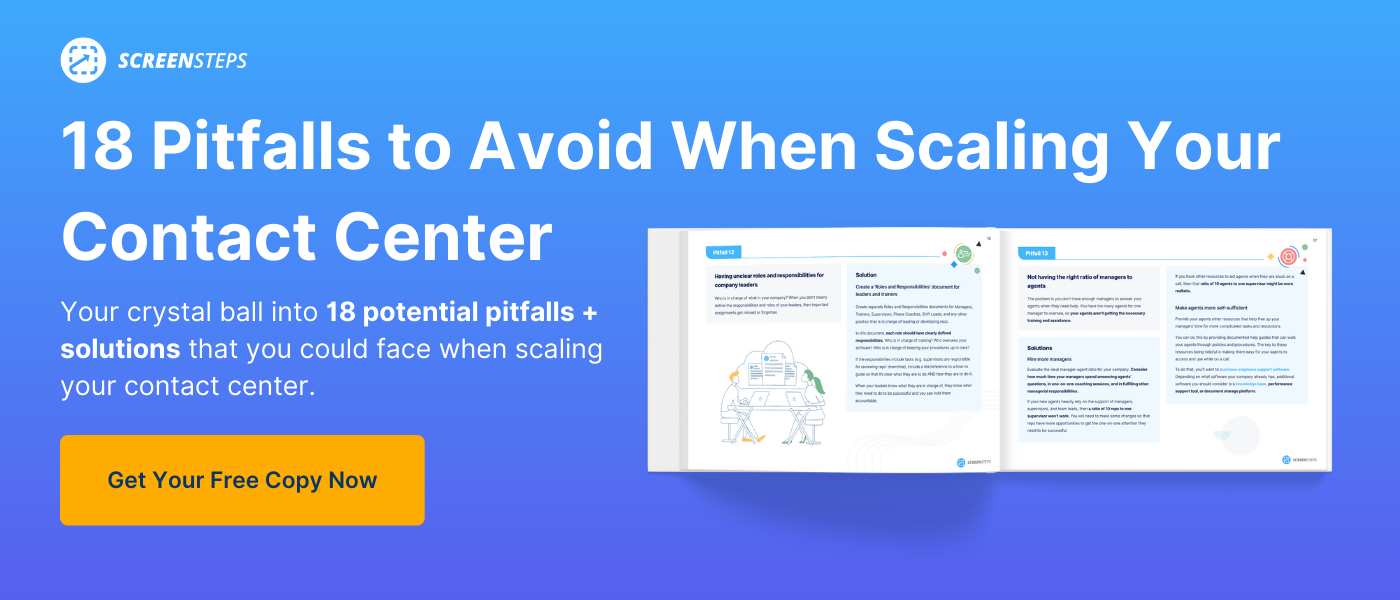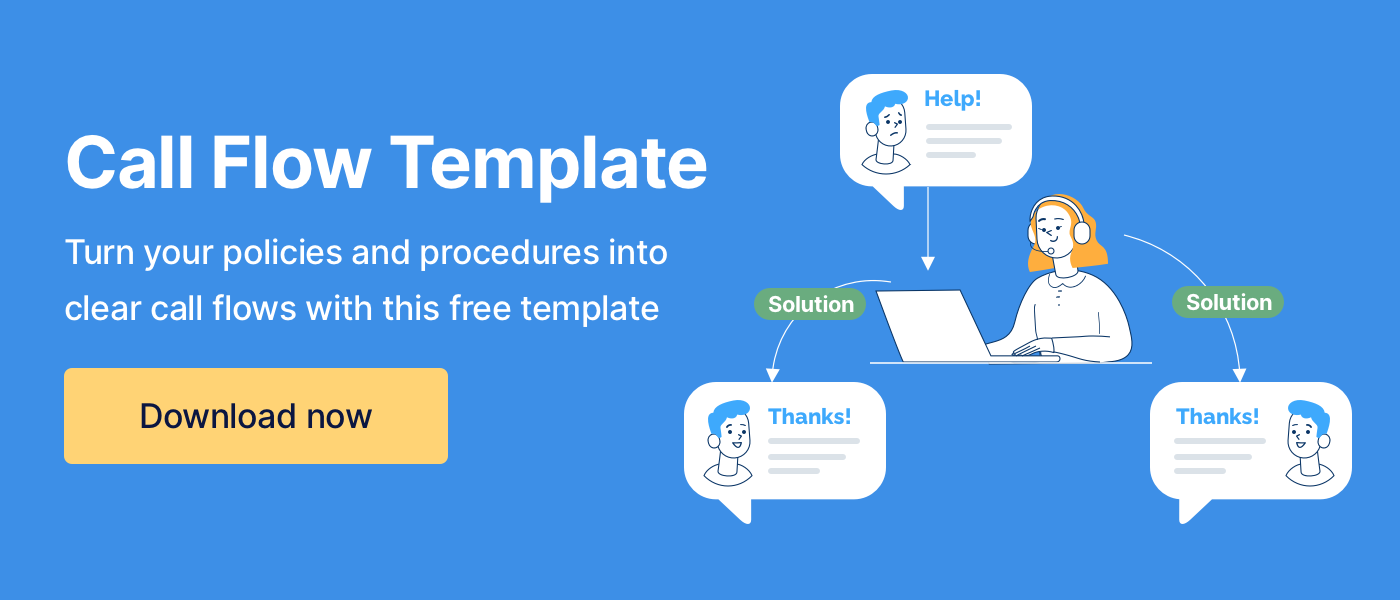How to Write Your First Call Flow if Your Call Center Doesn't Have Documented Procedures
Maybe you just got hired at your call center and have been tasked with creating call flows.
Or maybe you have been working at the call center for a while now and have finally decided it is time to buckle down and write call center call flows or call guides to support your agents.
Either way, the task can seem daunting. There is so much information to gather and so many questions:
- What do you really need to include in a call flow?
- What tools should you use to create the call flows?
- What are best practices for writing the call flows?
In this article, I am going to give you some tips to make the process more manageable and efficient.
Most importantly, I'm going to give you a process that will enable you to create call flows that are effective at helping your agents perform their jobs with fewer mistakes and questions.
The challenge — knowing where to start
The hardest part about starting with nothing is knowing where to begin. If you just start writing call center call flows without some careful planning, you will probably end up with complicated and confusing documents.
A little bit of planning will ensure that you create clearer and more effective call flows.
The problem is that, in most cases, there are no "easy" procedures. For example, if you are a medical organization, a likely situation would be a patient calling to check on the status of their bill.
If you talk through that scenario, you will see that there is a lot you need to document. The agent will need to be able to do the following:
- Greet the caller
- Verify that the caller is authorized to receive the information you are going to give them (HIPAA rules)
- Find the patient's account
- Provide the information
- Be able to answer questions that the patient will have depending on the status of the account
To make things even more complicated, the rules that your agents need to follow may be different depending on what type of patient is calling, what type of bill it is, what is the status of the bill, etc.
Is your head spinning yet? Well, it should be. But don't worry — we are going to simplify this a bit by following a five-step process:
5 Steps to Writing a Call Flow
Step 1: List specific scenarios
Scenarios describe situations that your agents are likely to encounter. At this stage of your call flow development, the more specific the scenario the better.
If we continue with our medical example from above, we might have the following scenarios where the:
- Caller is inquiring about a bill
- Caller calls to schedule an appointment
- Caller calls to cancel an appointment
- Provider calls to refer a patient
- Caller calls to update their insurance information
We want to list as many situations as our agents might encounter. By listing these scenarios, we will ensure that we are creating call flows that match situations the agents are really encountering.
If you don't have a list of the procedures and calls that your agents handle, then you'll want to run a Find & Follow Workshop. A Find & Follow Workshop helps you identify all the tasks and situations your call center agents encounter on their job.
Alternatively, you can spend a few days just listening to calls and writing down the scenarios your agents are encountering. (Warning: This second approach often leaves a lot of knowledge gaps.)
Step 2: Interview subject matter experts (SMEs)
The next step is to interview the subject matter experts (SMEs) as well as the agents.
If you aren't already using documented call flows in your call center, then you'll likely see differences between what your SMEs say should happen on a call and what the agents are actually doing.
Part of your job is going to be to reconcile these two versions of what should happen and document it in the call flow.
We suggest doing the following:
1. List the possible outcomes for a single scenario
First, take a single scenario and come up with a few variations. For example, with the "Caller is inquiring about a bill" we might come up with the following variations:
- Patient calls about a bill with an outstanding balance
- Relative of the patient calls about a bill with an outstanding balance
- Patient calls about a bill that has been paid
- Patient calls about a bill that has been sent to collections
These more specific variations will help us get all of the details we will need for the call flow.
2. Ask SMEs how to handle scenarios
After you have the scenarios listed, ask the SME to describe how they would handle each situation and document their answers as a bulleted list.
Step 3: Interview agents and reconcile the procedure
Now, you want to take those same scenarios and ask the actual agents how they would handle each situation. As you are talking to them, compare what they are saying to the list you wrote down from the SME.
You are probably going to notice some differences. Add notes to your list of actions. You might want to interview several agents because each one will probably give you a slightly different answer. Keep adding notes to your list to account for each variation.
Next, you will need to go back to the SMEs and discuss what you learned from the agents.
Merge your findings into a single call flow
Ultimately, you have to come up with a single call flow. There may need to be some further discussions and negotiations between the SMEs and agents — and that is all right.
The purpose at this point is to get everyone to agree on what the actual procedure should be.
If you don't follow this process, then you will likely have to change your call flow multiple times after you develop it.
Either the SMEs will say you left something out, or the agents will say, "That isn't actually how we do that." A little bit of planning and investigation work upfront will save a lot of frustration later on.
Step 4: Write down the critical path and variations
The final part of your planning is to write down the "Critical Path" along with all variations in a nested bulleted list.
The critical path documents the milestones and decision points in a given scenario. Here is an example of what a critical path might look like:

After you have the critical path, you then want to list out the variations. It is best to list these as yes/no questions whenever possible. Using yes/no questions will make the call flow easier for the agent to scan while they are on a call.
Pro Tip: Ideally, you would use a call flow software with interactive workflows. This could be a knowledge base, knowledge ops platform, or another knowledge management software.
Here is an example of what that might look like:

🔍 Related: How Should You Write Your Call Center Call Flows? (3 Options)
Step 5: Fill in the details and format for clarity
At this point, you should have a clearly formatted list of the critical path along with all variations. The final step is to add in the details needed to complete the call and format it for clarity.
Adding the details means walking through the procedures and making sure your agents would be able to follow the guide to handle a call without asking any questions.
The goal is to have a call flow that enables your call center agents to work 100% independently.
That means you need to you'll want to provide prompts (and sometimes scripted phrases) for all the different parts of your call flows from greeting to closing.
Once you've completed one call flow, you can start over again with one of the seven different types of call flows.
Ready to write your first call flow?
Hopefully, this article has helped you come up with a plan for capturing the information you need to develop effective call flows in your call center.
It can be intimidating to start writing call flows for your call center. There is a lot of information to include and you need to present it in a way that is easy for your call center agents to use while they are on a call.
With ScreenSteps' knowledge base software, it is easy to organize your call center call flows into a format that is easy for your call center agents to follow. Integrated screen capture, foldable sections, and other powerful tools make authoring call flows fast and simple.
Plus, when agents follow these clearly written guides on calls, they don't need to put callers on hold.
Now that you've learned how to write a call flow, it's your turn! To make it easier to get started, we've put together a simple core call flow template. Download the template for free and get started writing call flows for your call center today.





